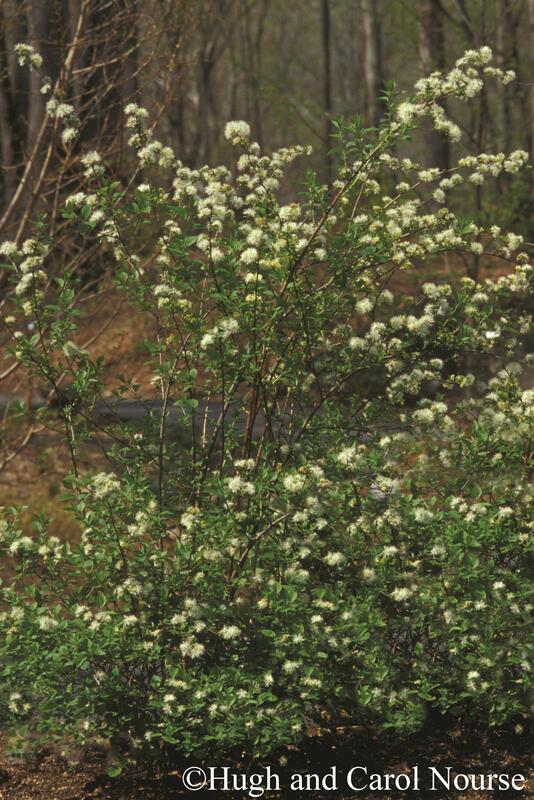







Loading profile. Please wait . . .
Neviusia alabamensis Gray
Alabama Snow-wreath




Federal Protection: No US federal protection
State Protection: Threatened
Global Rank: G3
State Rank: S1
Element Locations Tracked in Biotics: Yes
SWAP 2015 Species of Greatest Conservation Need (SGCN): Yes
SWAP 2025 Species of Greatest Conservation Need (SGCN): Yes
2025 SGCN Priority Tier: High Conservation Concern
Element Occurrences (EOs) in Georgia: 7
Habitat Summary for element in Georgia: Along wet weather streams over limestone
Shrub forming colonies of arching branches to 6 feet (2 meters) tall, with reddish-brown, zigzag twigs; the bark near the base of branches is reddish and shredding. The leaves are 0.8 - 3.5 inches (2 - 9 cm) long and 0.4 - 1.6 inch (1 - 4 cm) wide, alternate, deciduous, oval to heart-shaped, hairy on both surfaces; the leaf margins are sharply toothed, each large tooth usually has a smaller tooth; each tooth is tipped with a round, red gland. Leaf stalks are up to 0.4 inch (1 cm) long with a pair of small, pointed, green or brown stipules at the base. Flower clusters are held at the tips of branches and have 2 - 10 flowers per cluster. The flowers are about 1 inch (2.5 cm) across and showy; there are 4 - 5 greenish-white sepals and no petals but there are 100+ showy, white stamens; the flower stalks are hairy, less than 0.8 inch (1.5 - 2 cm) long. The fruits are dry achenes that are less than 0.2 inch (5 mm) long, oval, lopsided, hairy, surrounded by a low rim that holds withered stamens and sepals; seeds rarely develop.
Other rose family shrubs such as Sweet-spire (Spiraea spp.) and Nine-bark (Physocarpus opulifolius) have shredding bark and toothed leaves, but their flowers have 5 white petals.
None in Georgia.
Moist, hardwood forests over rocky, limestone-based soils, often along streams below sandstone caprocks.
Alabama Snow-wreath reproduces primarily from root sprouts, forming thickets; although fruits are occasionally set, seeds rarely if ever mature, and seedlings have never been seen.
Surveys are best conducted during flowering (late March–April) and fruiting (June–October).
Georgia, Alabama, Mississippi, Tennessee, Arkansas, and Missouri. It is rare throughout its range. Alabama Snow-wreath is widely available in the horticulture trade and may be found as a garden escape outside its original range.
Conversion of habitat including logging, clearing, and development. Invasion by exotic pest plants, especially Japanese Honeysuckle and Kudzu.
| Threat 1 | Threat 2 | Threat 3 | |
|---|---|---|---|
| General Threat | Other options | Natural system modifications | Invasive & other problematic species, genes & diseases |
| Specific Threat | None | None | None |
Neviusia alabamensis is ranked S1 by the Georgia Department of Natural Resources, indicating that it is critically imperiled in Georgia. Five populations are known, four on state-owned conservation land. One site on private land is threatened by mining.
Avoid logging, clearing, and development on ridges and in streamside zones. Eradicate exotic pest plants, especially Japanese Honeysuckle and Kudzu. Research the causes of poor reproduction in this species.
Chafin, L.G. 2007. Field guide to the rare plants of Georgia. State Botanical Garden of Georgia and University of Georgia Press, Athens.
Clark, J. 2004. Wildflowers of Pigeon Mountain, Lookout Mountain, Cloudland Canyon State Park, and Chickamauga National Military Park in northwest Georgia. Waldenhouse Publishers, Walden, Tennessee.
Coile, N.C. 1988. New to Georgia: Neviusia alabamensis, Cotinus obovatus, Aesculus glabra, and Stylophorum diphyllum. Castanea 53(4): 309-310. https://www.jstor.org/stable/pdf/4033548.pdf?ab_segments=0%252Fbasic_SYC-5055%252Ftest&refreqid=excelsior%3Afe90c88b31922d28a8f3ab90bdb14791
Foote, L.E. and S.B. Jones, Jr. 1989. Native shrubs and woody vines of the southeast. Timber Press, Portland, Oregon.
Freiley, K.J. 1994. Clonal diversity patterns in marginal populations of the geographically restricted shrub Neviusia alabamensis (Rosaceae). Southwestern Naturalist 39(1): 34-39.
GADNR. 2020. Element occurrence records for Neviusia alabamensis. Georgia Department of Natural Resources, Wildlife Resources Division, Social Circle, Georgia.
Heikens, A.L. Neviusia alabamensis species account. Flora of North America, vol. 9. http://www.efloras.org/florataxon.aspx?flora_id=1&taxon_id=220009234
Kral, R. 1983. A report on some rare, threatened, or endangered forest-related vascular plants of the South. Technical Publication R8-TP2. United States Forest Service, Atlanta.
Lance, R. 2004. Woody plants of the southeastern United States: a winter guide. University of Georgia Press, Athens.
NatureServe. 2019. Neviusia alabamensis comprehensive report. NatureServe Explorer. Arlington, Virginia. http://explorer.natureserve.org/servlet/NatureServe?searchName= Neviusia+alabamensis
Patrick, T.S., J.R. Allison, and G.A. Krakow. 1995. Protected plants of Georgia. Georgia Department of Natural Resources, Wildlife Resources Division, Social Circle.
Schotz, A.R. 1997. Status survey report on Neviusia alabamensis in Alabama. U.S. Fish and Wildlife Service. Jackson, Mississippi.
Weakley, A.S. 2015. Flora of the southern and mid-Atlantic States. University of North Carolina Herbarium, University of North Carolina, Chapel Hill. http://www.herbarium.unc.edu/flora.htm
Linda G. Chafin
L. Chafin, Jul. 2008: original account
K. Owers, Feb. 2010: added pictures
L. Chafin, Mar. 2020: updated original account.